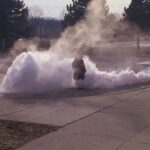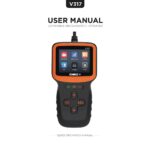Encountering a check engine light in your GM vehicle can be concerning, and deciphering the fault codes is the first step towards resolving the issue. Among the various OBD2 codes, Gm Obd2 Code P0128, indicating “Coolant Thermostat Below Regulating Temperature,” is a relatively common problem. This code signals that your engine isn’t reaching its optimal operating temperature within a specified timeframe, which can lead to reduced engine efficiency and potential long-term problems.
This comprehensive guide will delve into the intricacies of the P0128 code in GM vehicles. We’ll explore the common causes, symptoms, diagnostic procedures, and effective solutions to address this issue, ensuring your GM vehicle runs smoothly and efficiently.
Decoding the GM OBD2 Code P0128: Coolant Thermostat Below Regulating Temperature
The gm obd2 code p0128 is triggered when your vehicle’s Engine Control Module (ECM) or Powertrain Control Module (PCM) detects that the engine coolant temperature is not rising to the expected level within a predetermined period after engine start-up. The thermostat plays a crucial role in regulating engine temperature by controlling coolant flow. When the engine is cold, the thermostat remains closed, restricting coolant flow to help the engine warm up quickly. Once the engine reaches operating temperature, the thermostat opens, allowing coolant to circulate through the radiator to prevent overheating.
The ECM relies on the coolant temperature sensor to monitor the engine’s temperature. If the sensor readings indicate that the coolant temperature is consistently below the thermostat’s regulating temperature threshold for an extended period, the P0128 code is set, and the check engine light illuminates.
Recognizing the Symptoms of GM P0128 Code
While the check engine light is the most obvious indicator, several other symptoms may accompany the gm obd2 code p0128:
- Check Engine Light Illumination: This is the primary symptom, alerting you to a potential issue.
- Reduced Fuel Economy: A colder engine operates less efficiently, leading to increased fuel consumption.
- Decreased Engine Performance: The engine may feel sluggish or less responsive, particularly in colder weather.
- Heater Performance Issues: In cold climates, you might notice reduced heat output from your vehicle’s heater, as the coolant isn’t reaching optimal temperature.
- Engine Running Cooler Than Normal: While the temperature gauge might appear normal in some cases, the engine’s actual temperature is below the ideal operating range.
It’s important to address the P0128 code promptly, even if the symptoms seem minor initially. Prolonged operation with a cold-running engine can lead to increased engine wear, poor emissions, and decreased fuel efficiency.
Common Culprits Behind the GM P0128 Code
Several factors can contribute to the gm obd2 code p0128 in GM vehicles. Understanding these common causes is crucial for accurate diagnosis and effective repair:
1. Faulty Thermostat: Stuck Open or Failing
The most frequent cause of P0128 is a malfunctioning thermostat. Thermostats can fail in a couple of ways:
- Stuck Open Thermostat: If the thermostat is stuck in the open position, coolant continuously circulates through the radiator, preventing the engine from reaching its operating temperature quickly, especially in cold weather. This is the most common thermostat failure mode leading to P0128.
- Slow to Close Thermostat: In some cases, the thermostat might not be fully stuck open but could be slow to close or not closing completely. This also results in excessive coolant flow and delayed engine warm-up.
2. Low Engine Coolant Level
Insufficient coolant in the system can hinder proper heat retention and temperature regulation. Low coolant can be caused by:
- Coolant Leaks: Leaks in hoses, radiator, water pump, or engine block can gradually reduce coolant levels.
- Evaporation: Over time, some coolant evaporation is normal, but excessive evaporation may indicate a problem with the cooling system.
3. Malfunctioning Coolant Temperature Sensor
While less common than thermostat issues, a faulty coolant temperature sensor can also trigger P0128. If the sensor is providing inaccurate readings to the ECM, it might incorrectly indicate that the engine is running too cold, even if the actual temperature is within range.
4. Wiring and Connector Issues in the Coolant Temperature Sensor Circuit
Damaged, corroded, or loose wiring and connectors in the coolant temperature sensor circuit can disrupt the signal transmission to the ECM. This can lead to inaccurate temperature readings and potentially trigger the P0128 code. Inspect the wiring and connectors leading to the coolant temperature sensor for any signs of damage.
5. Radiator Fan Issues: Running Continuously
In rare cases, if the radiator fan is stuck in the “on” position or running continuously even when the engine is cold, it can overcool the engine and prevent it from reaching operating temperature, contributing to the P0128 code.
6. Engine Control Module (ECM) Problems
Although less frequent, a malfunctioning ECM could misinterpret sensor signals or have internal faults that lead to the erroneous setting of the P0128 code. ECM issues are usually diagnosed after ruling out all other potential causes.
Diagnosing the GM P0128 Code: A Step-by-Step Approach
Diagnosing the gm obd2 code p0128 effectively involves a systematic approach to pinpoint the root cause. Here’s a diagnostic process that both DIYers and professional mechanics can follow:
Step 1: OBD2 Scan and Code Verification
Use an OBD2 scanner to confirm the presence of the P0128 code and check for any other related trouble codes. Record all codes present. Clear the codes and take the vehicle for a test drive to see if the P0128 code returns. This helps ensure the code is not an intermittent issue.
Step 2: Visual Inspection of the Cooling System
Perform a thorough visual inspection of the cooling system:
- Check Coolant Level: Verify the coolant level in the overflow reservoir and radiator (when cold). If low, inspect for leaks.
- Inspect for Coolant Leaks: Examine hoses, radiator, water pump, thermostat housing, and engine block for any signs of coolant leaks (wet spots, stains, or coolant odor).
- Examine Wiring and Connectors: Inspect the wiring and connectors leading to the coolant temperature sensor for damage, corrosion, or loose connections.
Step 3: Thermostat Function Test
- Hose Temperature Check: With the engine cold, start the vehicle and let it idle. Carefully feel the upper radiator hose. It should remain relatively cool until the engine reaches operating temperature, at which point it should quickly become hot as the thermostat opens. If the upper hose heats up gradually from a cold start, it might indicate a stuck-open thermostat.
- Scan Tool Data Monitoring: A more precise method involves using a scan tool to monitor the coolant temperature sensor readings in real-time as the engine warms up. Observe how quickly the temperature rises. A slow or stagnant temperature rise suggests a thermostat issue.
Step 4: Coolant Temperature Sensor Testing
- Resistance Test: Disconnect the coolant temperature sensor and use a multimeter to measure its resistance. Compare the measured resistance to the manufacturer’s specifications for different temperatures. An out-of-spec reading indicates a faulty sensor.
- Sensor Voltage/Signal Check: With the sensor connected, use a multimeter or scan tool to check the voltage signal from the sensor to the ECM. Verify if the signal is within the expected range.
Step 5: Radiator Fan Operation Check
Observe the radiator fan operation when the engine is cold. Ensure the fan is not running continuously from a cold start. If it is, investigate the fan control system for potential faults.
Step 6: ECM Diagnosis (Last Resort)
If all other components test within specifications and the P0128 code persists, ECM malfunction becomes a possibility. ECM diagnosis often requires specialized tools and expertise and is typically performed by professional technicians.
Resolving the GM P0128 Code: Common Fixes
The appropriate solution for the gm obd2 code p0128 depends on the underlying cause identified during the diagnostic process. Here are the common repairs:
- Thermostat Replacement: If the thermostat is diagnosed as faulty (stuck open or slow to close), replacement is necessary. Ensure you use the correct thermostat type and temperature rating for your specific GM vehicle model.
- Coolant Leak Repair and Coolant Refill: If coolant leaks are found, repair them and refill the cooling system with the correct type and amount of coolant. Pressure testing the cooling system can help locate elusive leaks.
- Coolant Temperature Sensor Replacement: If the coolant temperature sensor is faulty, replace it with a new sensor.
- Wiring and Connector Repair/Replacement: Repair or replace any damaged, corroded, or loose wiring and connectors in the coolant temperature sensor circuit. Ensure proper electrical connections are restored.
- Radiator Fan Control System Repair: If the radiator fan is running continuously due to a control system fault, diagnose and repair the fan control circuit, relay, or fan clutch as needed.
- ECM Replacement or Reprogramming: In rare cases of ECM malfunction, replacement or reprogramming of the ECM might be required. This is typically a complex procedure performed by qualified technicians.
DIY vs. Professional Repair for P0128
For mechanically inclined individuals, some repairs for P0128, such as thermostat replacement, coolant temperature sensor replacement, and minor wiring repairs, can be performed as DIY projects. However, it’s crucial to have a good understanding of automotive repair procedures and access to necessary tools.
For complex diagnoses, coolant leak detection, radiator fan control system issues, and potential ECM problems, seeking professional mechanic assistance is recommended. Certified technicians have the expertise, diagnostic tools, and experience to accurately pinpoint the root cause and perform effective repairs, ensuring the P0128 code is resolved correctly and your GM vehicle operates reliably.
Conclusion: Addressing GM OBD2 Code P0128 for Optimal Engine Performance
The gm obd2 code p0128 signals a critical issue with your GM vehicle’s engine temperature regulation. Promptly addressing this code is essential to maintain optimal engine performance, fuel efficiency, and longevity. By understanding the causes, symptoms, and diagnostic procedures outlined in this guide, you can effectively tackle the P0128 code and ensure your GM vehicle runs at its best. Whether you choose to DIY some repairs or seek professional help, resolving the P0128 code will contribute to a healthier and more efficient vehicle.

